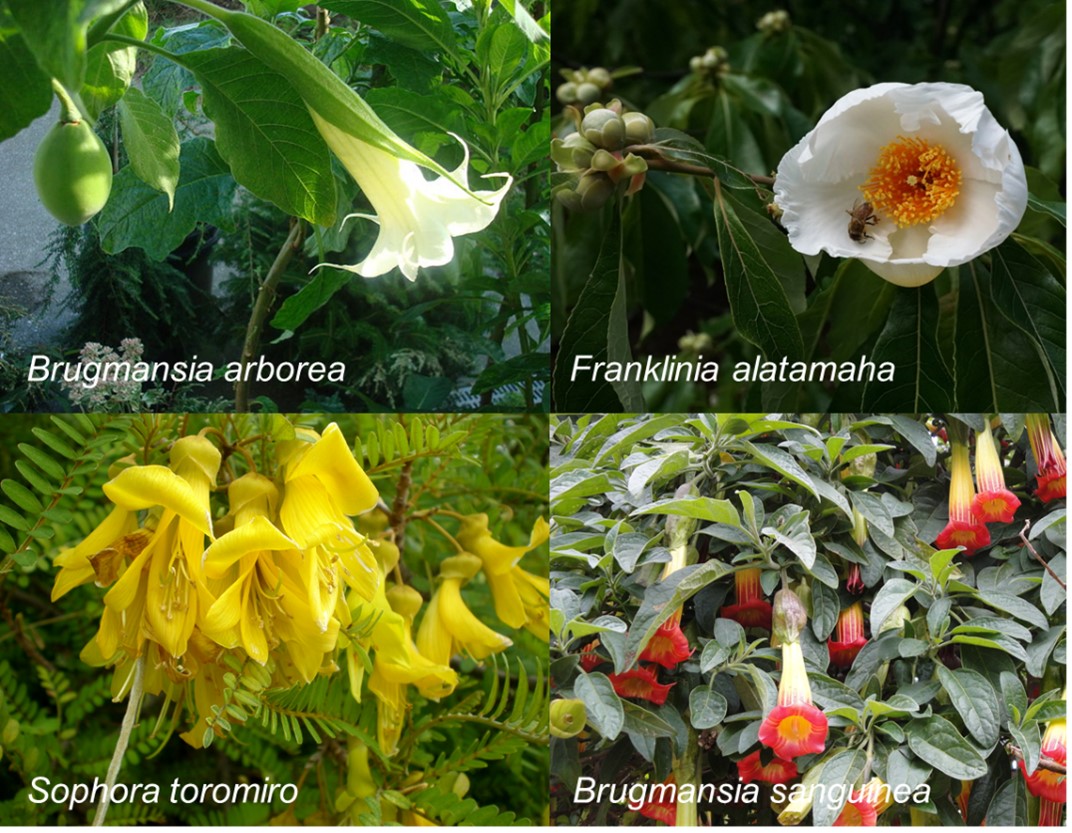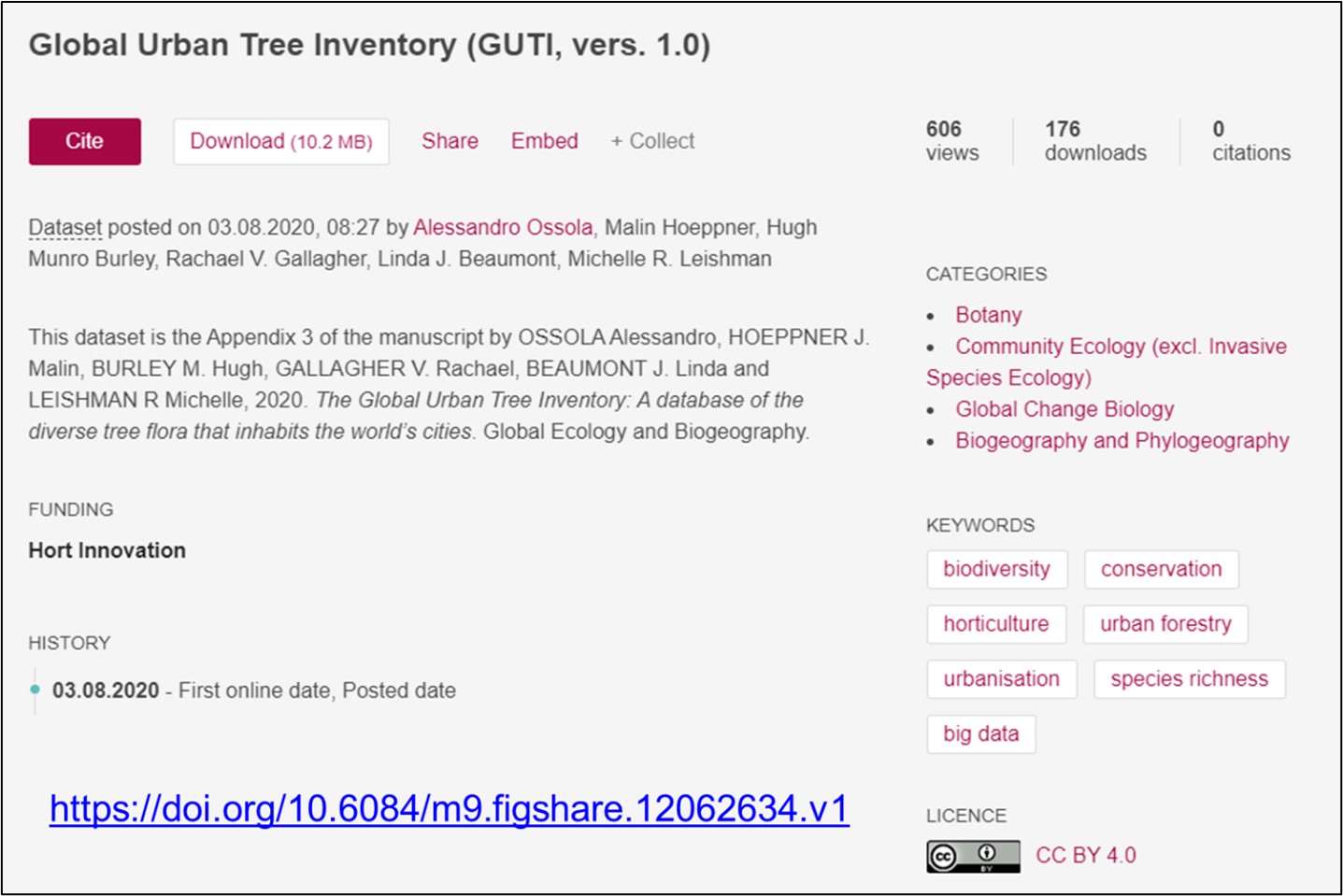Locations of the cities in the Global Urban Tree Inventory
Authors: Alessandro Ossola and Michelle Leishman, 23 Sept 2021
Humans have planted trees for amenity since the settlement of early cities and towns. Tree species have been traded among continents and spread far away from their native environments and climates, many making the long journey down under from the other side of the world. When travelling to a different city overseas, it is common to find some familiar species you might have seen in the streets around your home suburb. But have you ever wondered how many species of trees are planted in the world’s cities? Here we give you some answers!
The Global Urban Tree Inventory (GUTI)
We surveyed urban tree inventories and species lists of street trees planted in the world’s cities and towns in all populated continents and 73 countries, located in most climatic and eco-floristic zones (Fig. 1). Our research highlights that more than 4,700 tree species, 1200 genera and 150 families have been planted in 470 of the world’s urban areas (Ossola et al., 2020). This is quite an incredible species richness, which comprises about 8% of all tree species known to exist in nature. And that’s without even accounting for subspecies, varieties, cultivars, hybrids, etc. Our statistical models also suggest that, if we could sample all of the world’s cities and towns, we should expect to find about 8,500 species (14% of the world’s tree flora known to exist).
Among the tree species included in our Global Urban Tree Inventory (GUTI) database, we found that many urban tree species are at risk of extinction in the wild, based on the International Union for Conservation of Nature’s (IUCN) Red List of Threatened Species (https://www.iucnredlist.org/). Among them, four species of the genus Brugmansia (B. arborea, B. sanguinea, B. suaveolens, B. versicolor) – commonly known as angel’s trumpets – are considered ‘extinct in the wild’. Franklinia alatamaha (Franklin tree) and Sophora toromiro (Toromiro) are also considered extinct in nature but they can still be found in some cities and towns (Fig. 2). Out of the 4,700 species, more than 400 are listed as threatened on the IUCN Red List (Fig. 1). On the other hand, more than 300 planted species are considered as potential weeds as they are listed as invasive in at least one global location, based on the Global Register of Introduced and Invasive Species (GRIIS, http://www.griis.org/).

Figure 1: Summary of the coverage of the Global Urban Tree Inventory (GUTI) in relation to species taxonomic makeup and conservation/threat status, geographic and climate distribution (Ossola et al., 2020).
How to use GUTI to inform your tree species selection
The Global Urban Tree Inventory (GUTI) (Ossola et al., 2020) is the first taxonomically-updated and comprehensive database of the tree species found in the world’s urban areas. Version 1.0 of GUTI is freely available for consultation and download at this link: https://doi.org/10.6084/m9.figshare.12062634.v1 as a Microsoft Excel readable .xlsx file (Fig. 3). The GUTI database comes in several tables as follows:
- Table 3.1 – this table includes all the cities and towns included in GUTI for which we found street tree inventory or tree species list data. For each we include information on geographic location, climate and ecofloristic zones, and population size. Maybe your location is listed here?
- Table 3.2 – includes the updated taxonomic information for all the 4,734 tree species included in GUTI. Can you find your favourite species here?
- Table 3.3 and 3.4 – only for the botanical aficionados! these tables contain more information about species and family synonyms and the taxonomic validation we performed.
- Table 3.5 – perhaps the most important table of all, this presence/absence matrix indicates whether each species is present (1) or absent (0) from a certain urban location or country. Species are ranked from the most to least common; Ginkgo biloba is unsurprisingly the most common urban tree in the world and planted in more than 217 urban areas globally, yet it was once thought to be extinct in the wild! Which species were you thinking about?
- Table 3.6 – Interested in biological conservation? Want to support a rare or endangered species? You might want to check out this table where we list all the 1,643 GUTI trees included in the International Union for Conservation of Nature’s (IUCN) Red List of Threatened Species (https://www.iucnredlist.org/), alongside their current threat status.
- Table 3.7 – Equally important, this table lists tree species’ invasive status by country as reported in the Global Register of Introduced and Invasive Species (GRIIS, http://www.griis.org/). Better check out whether your favourite species is not spreading in the wild somewhere else in the world!

Figure 2: Images of four plant species thought to be Extinct in the Wild (IUCN’s Red List of Threatened Species) but still found planted in some of the world’s cities, based on data from the Global Urban Forest Inventory (Ossola et al., 2020). (Image courtesy: Tom Hulse, Plant Image Library, Consultaplantas, Janey Henning via Wikimedia Commons).
What you can do with GUTI
- Urban climate analogs – by querying the Global Urban Tree Inventory (GUTI) database you can simply find the urban areas with the climate most similar to yours (known as analogs) in terms of mean annual temperature, mean annual precipitation or Koppen Climate Zone. Then you can check which tree species have been planted and are growing in your urban climate analogs to get some ideas on what to plant at your own location.
- Turning up the heat and turn down the water – as seen for the climate analogs, you can also find which tree species are currently planted in warmer and drier urban areas compared to yours. You might get some good ideas for species and genera to consider when thinking about urban plantings in hotter and water-limited conditions.
- Help save biodiversity – plant diversity is under threat globally. Why not try to use your urban plantings to preserve some species struggling to survive in the wild? Maybe you can ask your favourite nursery to help grow these species in need of help!
- Weed out weeds and invaders – we all love the great Aussie bush. Before planting it is always better to check that horticultural species do not pose a threat for our native biodiversity. When selecting exotic species, you can opt for sterile cultivars, dioecious species, or plants not able to easily reproduce vegetatively to reduce risk. And check in the Which Plant Where tool if a species is declared as a weed in any Australian state or territory.

Figure 3: Screenshot of the Global Urban Tree Inventory (GUTI) database. This is freely available for download and consultation at https://doi.org/10.6084/m9.figshare.12062634.v1.
REFERENCES
Ossola, A., Hoeppner, J.M., Burley, H., Gallagher, R.V., Beaumont, L.J., Leishman, M.R., 2020. The Global Urban Tree Inventory: A database of the diverse tree flora that inhabits the world’s cities. Global Ecology and Biogeography, 29:1907-1914. https://doi.org/10.1111/geb.13169.

